Business Strategy of Daimler AG: Internal and External Analysis Report
VerifiedAdded on 2020/01/16
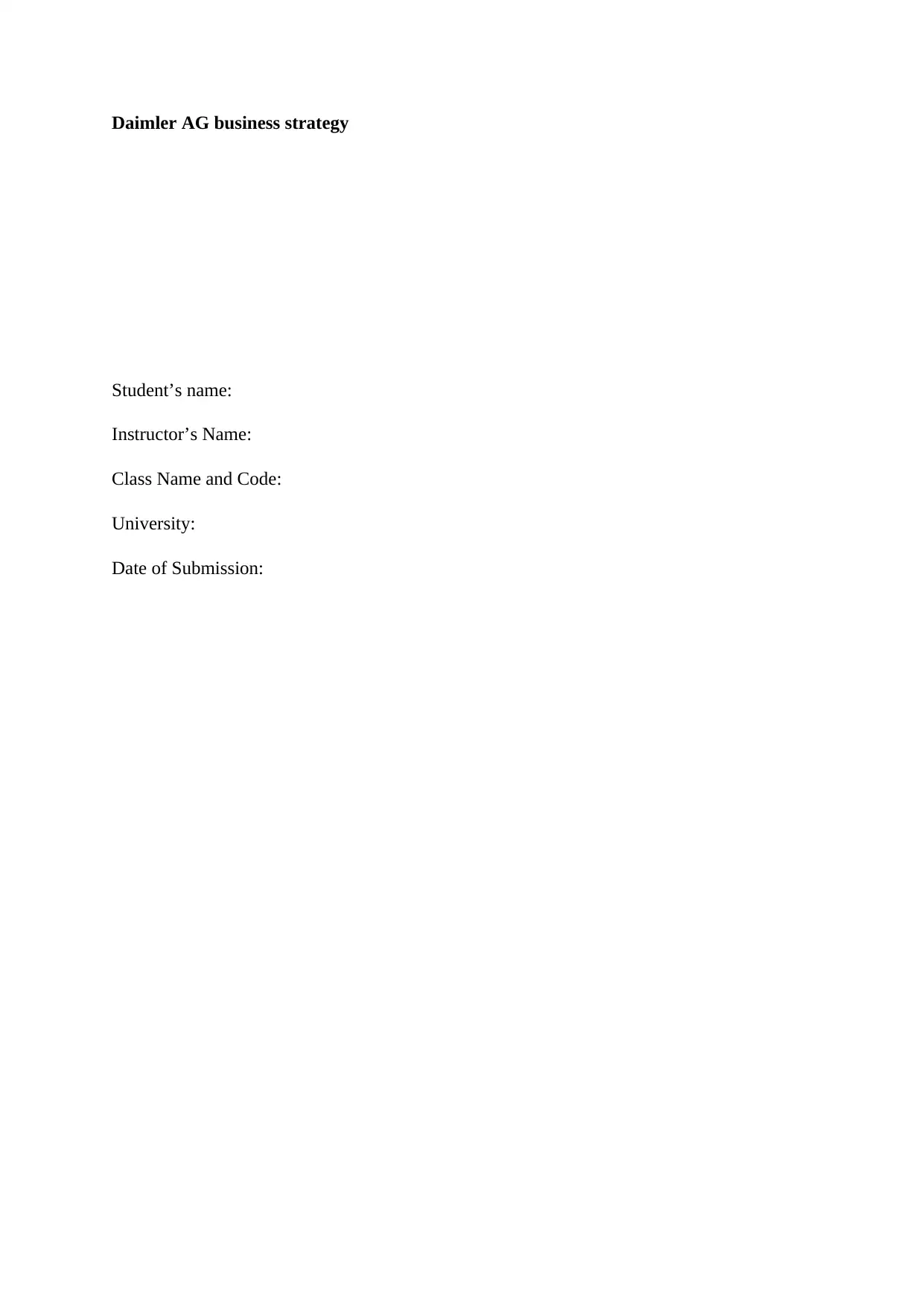
Student’s name:
Instructor’s Name:
Class Name and Code:
University:
Date of Submission:
Paraphrase This Document
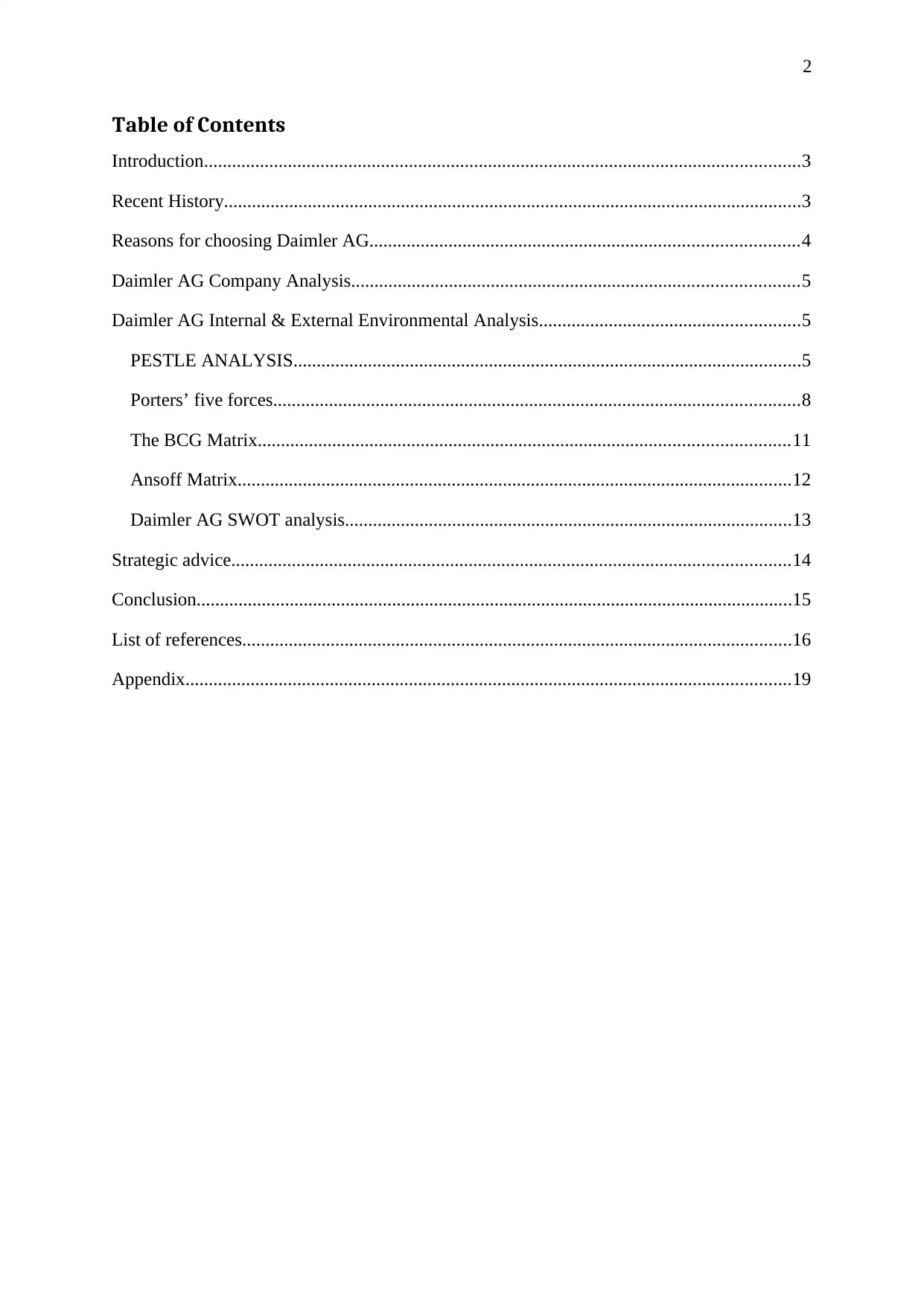
Table of Contents
Introduction................................................................................................................................3
Recent History............................................................................................................................3
Reasons for choosing Daimler AG............................................................................................4
Daimler AG Company Analysis................................................................................................5
Daimler AG Internal & External Environmental Analysis........................................................5
PESTLE ANALYSIS.............................................................................................................5
Porters’ five forces.................................................................................................................8
The BCG Matrix..................................................................................................................11
Ansoff Matrix.......................................................................................................................12
Daimler AG SWOT analysis................................................................................................13
Strategic advice........................................................................................................................14
Conclusion................................................................................................................................15
List of references......................................................................................................................16
Appendix..................................................................................................................................19

Introduction
Daimler AG is an internationally recognised automotive corporation.it is among the leading
truck and car manufacturer. Some of the vehicle brands produced by Daimler AG include:
Maybach (this is a luxury vehicle brand), Smart (small hybrid cars) and Mercedes Benz.
Information from Daimler AG (2007) reveals that commercial activity by Daimler is
conducted under several brands some of which include: Fuso, Orion, Freightliner, Western
Star, Sterling, Thomas Built Buses and Western Star. Daimler also involves itself in financial
services and technological research work. The headquarters of Daimler AG are in Stuttgart
Germany. Maybach brand had initially been halted in 2012 but in the year 2015 it was
revived under the brand name Mercedes Maybach (Daimler Ag., 2015). The Mercedes
Maybach is in the category of ultra-luxury automotive, an advanced edition of S-Class
Mercedes Benz. Daimler sales in 2016 were 3 million vehicles (Daimler, 2017). Gottlieb
Daimler and Karl Benz are credited for establishing the Daimler Benz company.
Recent History
According to EURO STOXX 50 (2015) Daimler is the 13th biggest manufacturer of cars and
the 2nd biggest manufacturer of trucks globally. Daimler AG announced intentions to merge
with Chrysler Corporation in 1988. The merger would cost Daimler Benz an excess of $35
billion in the form of stock swap. The merger agreement included retention of brand
identities of the two companies separately (Neubauer et al., 2000). This in essence meant that
no Chrysler dealership would sell Mercedes brands and neither would and Chrysler car bear
the star emblem of Mercedes (Daimler AG, 2007). In the year 2000 DaimlerChrysler
purchased 34% ownership of Mitsubishi in the quest to strengthen its power in the growing
automobile industry. This initiative propelled DaimlerChrysler to become the 3rd biggest
automotive manufacturer globally, only trailing General motors and Ford motor corporations.
In 2001 the company sold out Adtranz the rail system supplier in the interest of paying more
attention to the automotive business. The move to buy stakes in Mitsubishi was not
productive. In 2005 Daimler relinquished it share in Mitsubishi. In 2006 Chrysler reported
⊘ This is a preview!⊘
Do you want full access?
Subscribe today to unlock all pages.

Trusted by 1+ million students worldwide
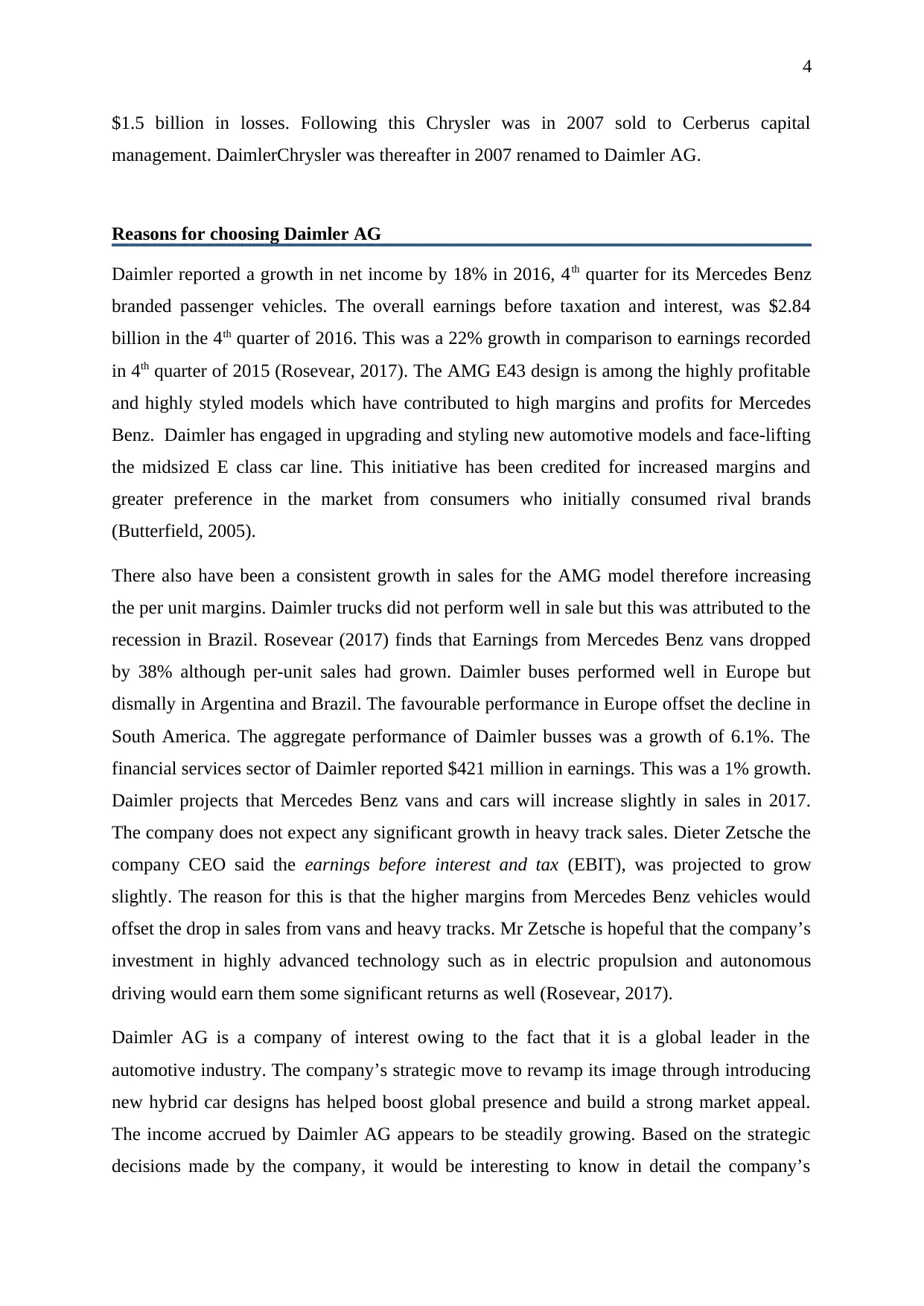
$1.5 billion in losses. Following this Chrysler was in 2007 sold to Cerberus capital
management. DaimlerChrysler was thereafter in 2007 renamed to Daimler AG.
Reasons for choosing Daimler AG
Daimler reported a growth in net income by 18% in 2016, 4th quarter for its Mercedes Benz
branded passenger vehicles. The overall earnings before taxation and interest, was $2.84
billion in the 4th quarter of 2016. This was a 22% growth in comparison to earnings recorded
in 4th quarter of 2015 (Rosevear, 2017). The AMG E43 design is among the highly profitable
and highly styled models which have contributed to high margins and profits for Mercedes
Benz. Daimler has engaged in upgrading and styling new automotive models and face-lifting
the midsized E class car line. This initiative has been credited for increased margins and
greater preference in the market from consumers who initially consumed rival brands
(Butterfield, 2005).
There also have been a consistent growth in sales for the AMG model therefore increasing
the per unit margins. Daimler trucks did not perform well in sale but this was attributed to the
recession in Brazil. Rosevear (2017) finds that Earnings from Mercedes Benz vans dropped
by 38% although per-unit sales had grown. Daimler buses performed well in Europe but
dismally in Argentina and Brazil. The favourable performance in Europe offset the decline in
South America. The aggregate performance of Daimler busses was a growth of 6.1%. The
financial services sector of Daimler reported $421 million in earnings. This was a 1% growth.
Daimler projects that Mercedes Benz vans and cars will increase slightly in sales in 2017.
The company does not expect any significant growth in heavy track sales. Dieter Zetsche the
company CEO said the earnings before interest and tax (EBIT), was projected to grow
slightly. The reason for this is that the higher margins from Mercedes Benz vehicles would
offset the drop in sales from vans and heavy tracks. Mr Zetsche is hopeful that the company’s
investment in highly advanced technology such as in electric propulsion and autonomous
driving would earn them some significant returns as well (Rosevear, 2017).
Daimler AG is a company of interest owing to the fact that it is a global leader in the
automotive industry. The company’s strategic move to revamp its image through introducing
new hybrid car designs has helped boost global presence and build a strong market appeal.
The income accrued by Daimler AG appears to be steadily growing. Based on the strategic
decisions made by the company, it would be interesting to know in detail the company’s
Paraphrase This Document
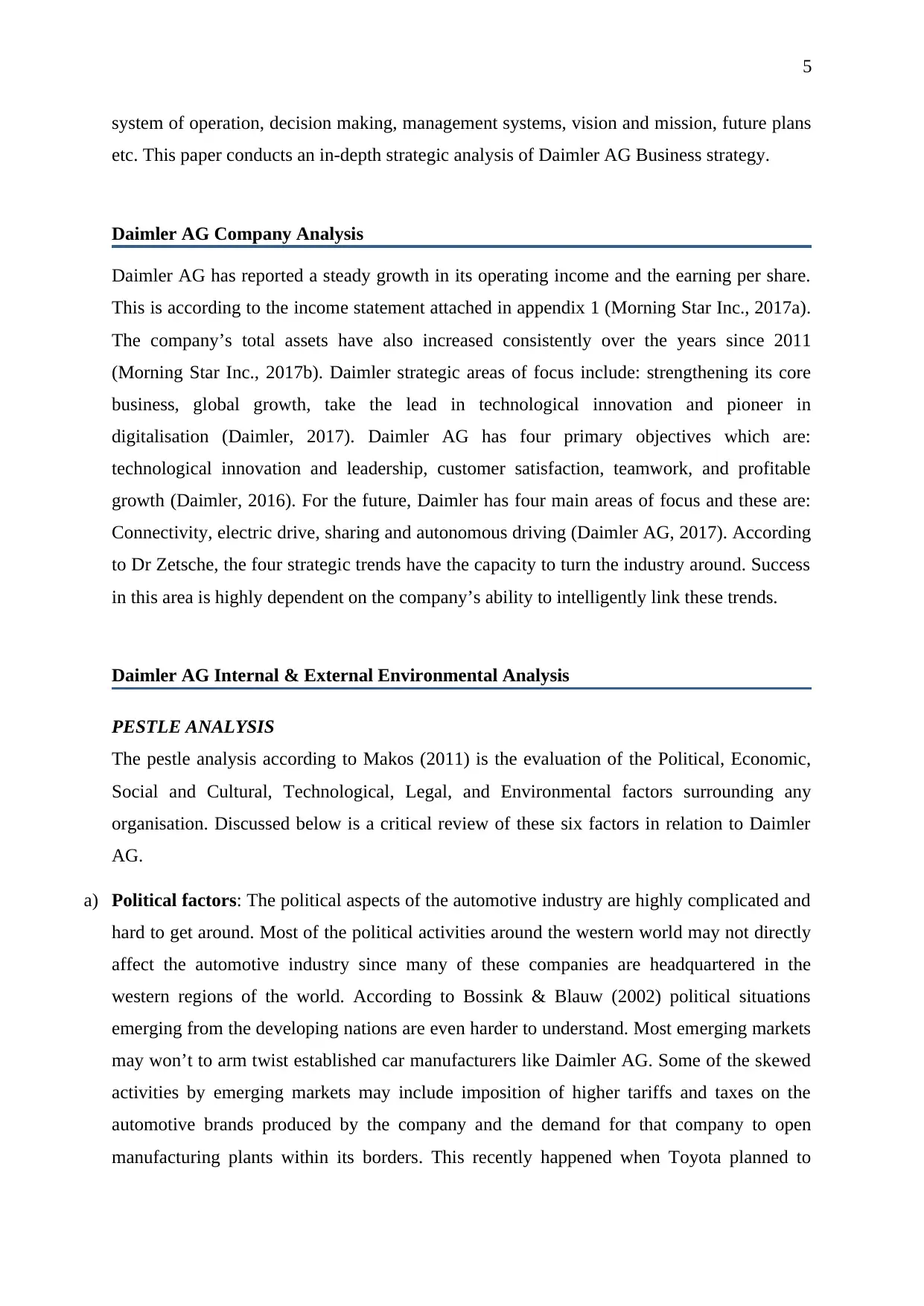
system of operation, decision making, management systems, vision and mission, future plans
etc. This paper conducts an in-depth strategic analysis of Daimler AG Business strategy.
Daimler AG Company Analysis
Daimler AG has reported a steady growth in its operating income and the earning per share.
This is according to the income statement attached in appendix 1 (Morning Star Inc., 2017a).
The company’s total assets have also increased consistently over the years since 2011
(Morning Star Inc., 2017b). Daimler strategic areas of focus include: strengthening its core
business, global growth, take the lead in technological innovation and pioneer in
digitalisation (Daimler, 2017). Daimler AG has four primary objectives which are:
technological innovation and leadership, customer satisfaction, teamwork, and profitable
growth (Daimler, 2016). For the future, Daimler has four main areas of focus and these are:
Connectivity, electric drive, sharing and autonomous driving (Daimler AG, 2017). According
to Dr Zetsche, the four strategic trends have the capacity to turn the industry around. Success
in this area is highly dependent on the company’s ability to intelligently link these trends.
Daimler AG Internal & External Environmental Analysis
PESTLE ANALYSIS
The pestle analysis according to Makos (2011) is the evaluation of the Political, Economic,
Social and Cultural, Technological, Legal, and Environmental factors surrounding any
organisation. Discussed below is a critical review of these six factors in relation to Daimler
AG.
a) Political factors: The political aspects of the automotive industry are highly complicated and
hard to get around. Most of the political activities around the western world may not directly
affect the automotive industry since many of these companies are headquartered in the
western regions of the world. According to Bossink & Blauw (2002) political situations
emerging from the developing nations are even harder to understand. Most emerging markets
may won’t to arm twist established car manufacturers like Daimler AG. Some of the skewed
activities by emerging markets may include imposition of higher tariffs and taxes on the
automotive brands produced by the company and the demand for that company to open
manufacturing plants within its borders. This recently happened when Toyota planned to

open a production plant in Mexico. The main objective was to export the cars into USA. U.S.
president Donald Trump was however opposed to this idea saying that he would impose hefty
taxes if Toyota went ahead to do so. The idea behind such a move is to have Toyota open the
production plant in USA instead and hire U.S. workers. Such political activities derail the
company’s penetration speed into emerging markets and hence affect its revenue growth
(Apfelthaler et al., 2002). Even though Brexit and the election of Donald J. Trump as the new
American president may not immediately affect Daimler AG, Britain is more likely to
renegotiate trade deals with Germany. The future with respect to the British market is
certainly uncertain. The current narrative of buy America and higher America adopted by
Donald Trump is also likely to affect Daimler’s business in the US.
b) Economic Factors: According to Matthews (2017) there are five economic signs that
everyone should watch out for in 2017 and they are: Brexit, China’s economic slowdown,
Trump’s election as US president, Federal serve bank and global trade. Trump is likely to
introduce new tax policies on automotive manufacturers. The Economic slowdown expected
in China is likely to affect its purchasing power subsequently reducing imports. This in a way
may affect Daimler AG. The European Union appears to be at stake now. With Britain’s exit
and reported discontent in some countries like Italy and France, the future of the Union
appear fragile. Political parties that support the European Union seem to be losing popularity.
These political trends will definitely impact on the economy. There are some research
findings suggesting that automotive companies are in recent times consuming large quantities
of iron, steel, computer chips, rubber, textile and plastics. The automotive industry is
definitely a market for many other market products hence contributing to increased
employment even on other economic sectors. The political environment being central to
taxation and trade policies, affects the economy fundamentally and the automotive industry is
not immune to this.
c) Social & cultural factors: The cultural and social psychology in many societies is that
anyone driving a luxuries and high class car is viewed as powerful, noble and wealthy (Kraus
& Keltner, 2009). Even though there are fundamental differences in cultures around the
world the globalisation effect has inherently influenced consumer behaviour and buying
habits. Both the emerging economies and the developed world seem to agree on the symbols
of stature. The Mercedes Maybach model is globally accepted as a symbol of luxury and
wealth perhaps. Most consumers would want to taste the feeling of class and elegance that
Maybach offers. This said however, there is a high likelihood that style and design of a car
will affect consumer preferences anywhere in the world (Mihic et al., 2013). This explains
⊘ This is a preview!⊘
Do you want full access?
Subscribe today to unlock all pages.

Trusted by 1+ million students worldwide
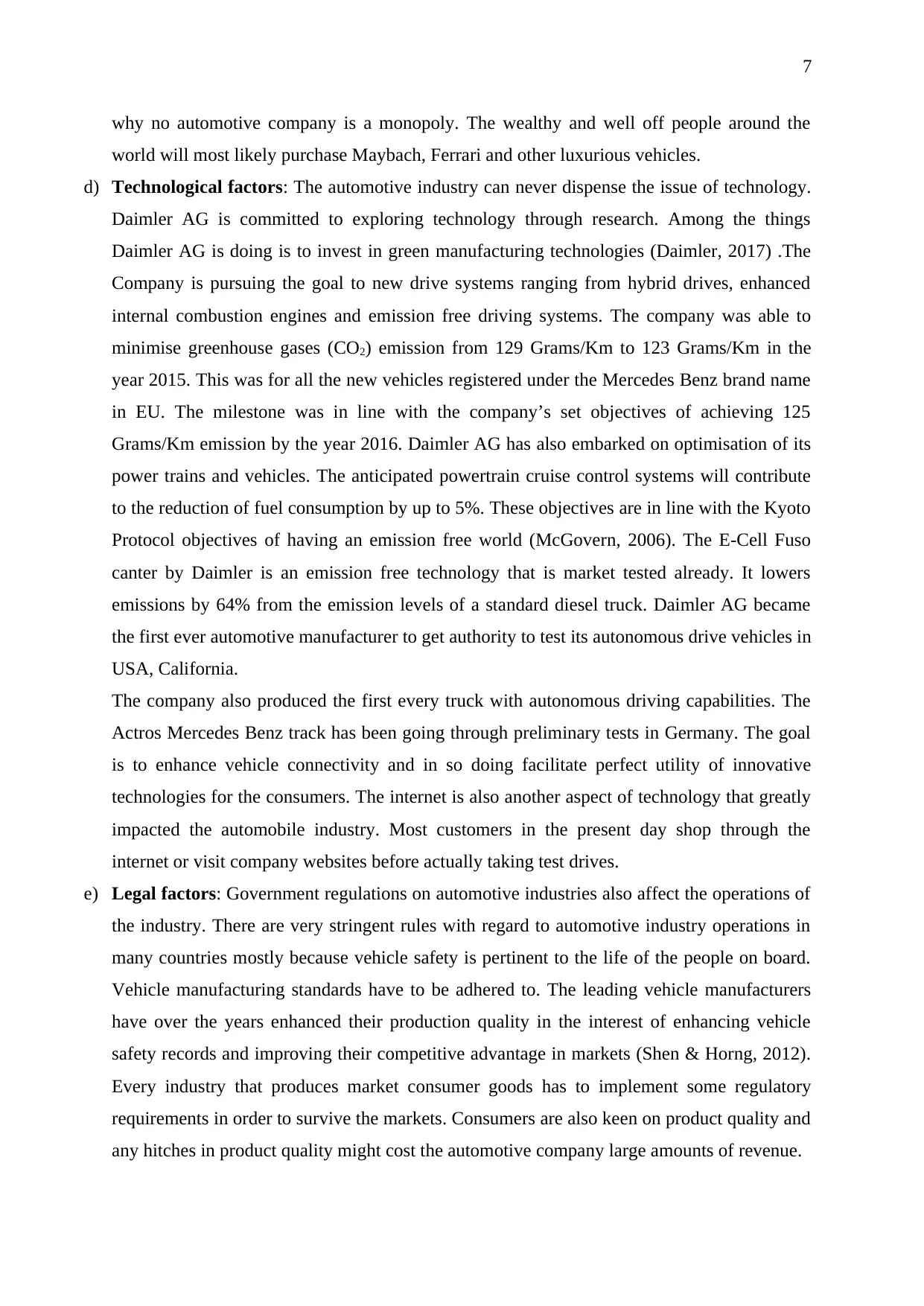
why no automotive company is a monopoly. The wealthy and well off people around the
world will most likely purchase Maybach, Ferrari and other luxurious vehicles.
d) Technological factors: The automotive industry can never dispense the issue of technology.
Daimler AG is committed to exploring technology through research. Among the things
Daimler AG is doing is to invest in green manufacturing technologies (Daimler, 2017) .The
Company is pursuing the goal to new drive systems ranging from hybrid drives, enhanced
internal combustion engines and emission free driving systems. The company was able to
minimise greenhouse gases (CO2) emission from 129 Grams/Km to 123 Grams/Km in the
year 2015. This was for all the new vehicles registered under the Mercedes Benz brand name
in EU. The milestone was in line with the company’s set objectives of achieving 125
Grams/Km emission by the year 2016. Daimler AG has also embarked on optimisation of its
power trains and vehicles. The anticipated powertrain cruise control systems will contribute
to the reduction of fuel consumption by up to 5%. These objectives are in line with the Kyoto
Protocol objectives of having an emission free world (McGovern, 2006). The E-Cell Fuso
canter by Daimler is an emission free technology that is market tested already. It lowers
emissions by 64% from the emission levels of a standard diesel truck. Daimler AG became
the first ever automotive manufacturer to get authority to test its autonomous drive vehicles in
USA, California.
The company also produced the first every truck with autonomous driving capabilities. The
Actros Mercedes Benz track has been going through preliminary tests in Germany. The goal
is to enhance vehicle connectivity and in so doing facilitate perfect utility of innovative
technologies for the consumers. The internet is also another aspect of technology that greatly
impacted the automobile industry. Most customers in the present day shop through the
internet or visit company websites before actually taking test drives.
e) Legal factors: Government regulations on automotive industries also affect the operations of
the industry. There are very stringent rules with regard to automotive industry operations in
many countries mostly because vehicle safety is pertinent to the life of the people on board.
Vehicle manufacturing standards have to be adhered to. The leading vehicle manufacturers
have over the years enhanced their production quality in the interest of enhancing vehicle
safety records and improving their competitive advantage in markets (Shen & Horng, 2012).
Every industry that produces market consumer goods has to implement some regulatory
requirements in order to survive the markets. Consumers are also keen on product quality and
any hitches in product quality might cost the automotive company large amounts of revenue.
Paraphrase This Document
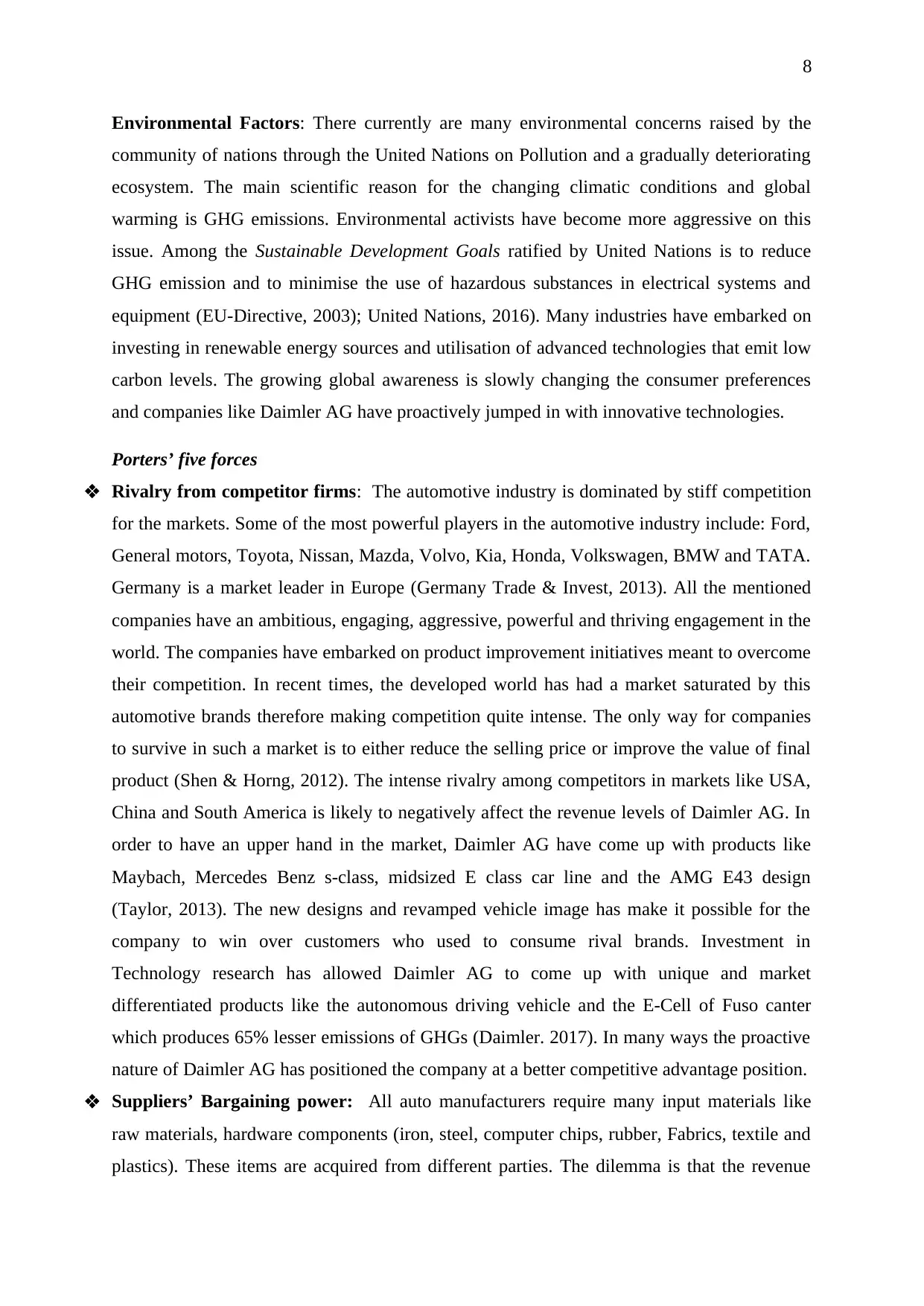
Environmental Factors: There currently are many environmental concerns raised by the
community of nations through the United Nations on Pollution and a gradually deteriorating
ecosystem. The main scientific reason for the changing climatic conditions and global
warming is GHG emissions. Environmental activists have become more aggressive on this
issue. Among the Sustainable Development Goals ratified by United Nations is to reduce
GHG emission and to minimise the use of hazardous substances in electrical systems and
equipment (EU-Directive, 2003); United Nations, 2016). Many industries have embarked on
investing in renewable energy sources and utilisation of advanced technologies that emit low
carbon levels. The growing global awareness is slowly changing the consumer preferences
and companies like Daimler AG have proactively jumped in with innovative technologies.
Porters’ five forces
Rivalry from competitor firms: The automotive industry is dominated by stiff competition
for the markets. Some of the most powerful players in the automotive industry include: Ford,
General motors, Toyota, Nissan, Mazda, Volvo, Kia, Honda, Volkswagen, BMW and TATA.
Germany is a market leader in Europe (Germany Trade & Invest, 2013). All the mentioned
companies have an ambitious, engaging, aggressive, powerful and thriving engagement in the
world. The companies have embarked on product improvement initiatives meant to overcome
their competition. In recent times, the developed world has had a market saturated by this
automotive brands therefore making competition quite intense. The only way for companies
to survive in such a market is to either reduce the selling price or improve the value of final
product (Shen & Horng, 2012). The intense rivalry among competitors in markets like USA,
China and South America is likely to negatively affect the revenue levels of Daimler AG. In
order to have an upper hand in the market, Daimler AG have come up with products like
Maybach, Mercedes Benz s-class, midsized E class car line and the AMG E43 design
(Taylor, 2013). The new designs and revamped vehicle image has make it possible for the
company to win over customers who used to consume rival brands. Investment in
Technology research has allowed Daimler AG to come up with unique and market
differentiated products like the autonomous driving vehicle and the E-Cell of Fuso canter
which produces 65% lesser emissions of GHGs (Daimler. 2017). In many ways the proactive
nature of Daimler AG has positioned the company at a better competitive advantage position.
Suppliers’ Bargaining power: All auto manufacturers require many input materials like
raw materials, hardware components (iron, steel, computer chips, rubber, Fabrics, textile and
plastics). These items are acquired from different parties. The dilemma is that the revenue
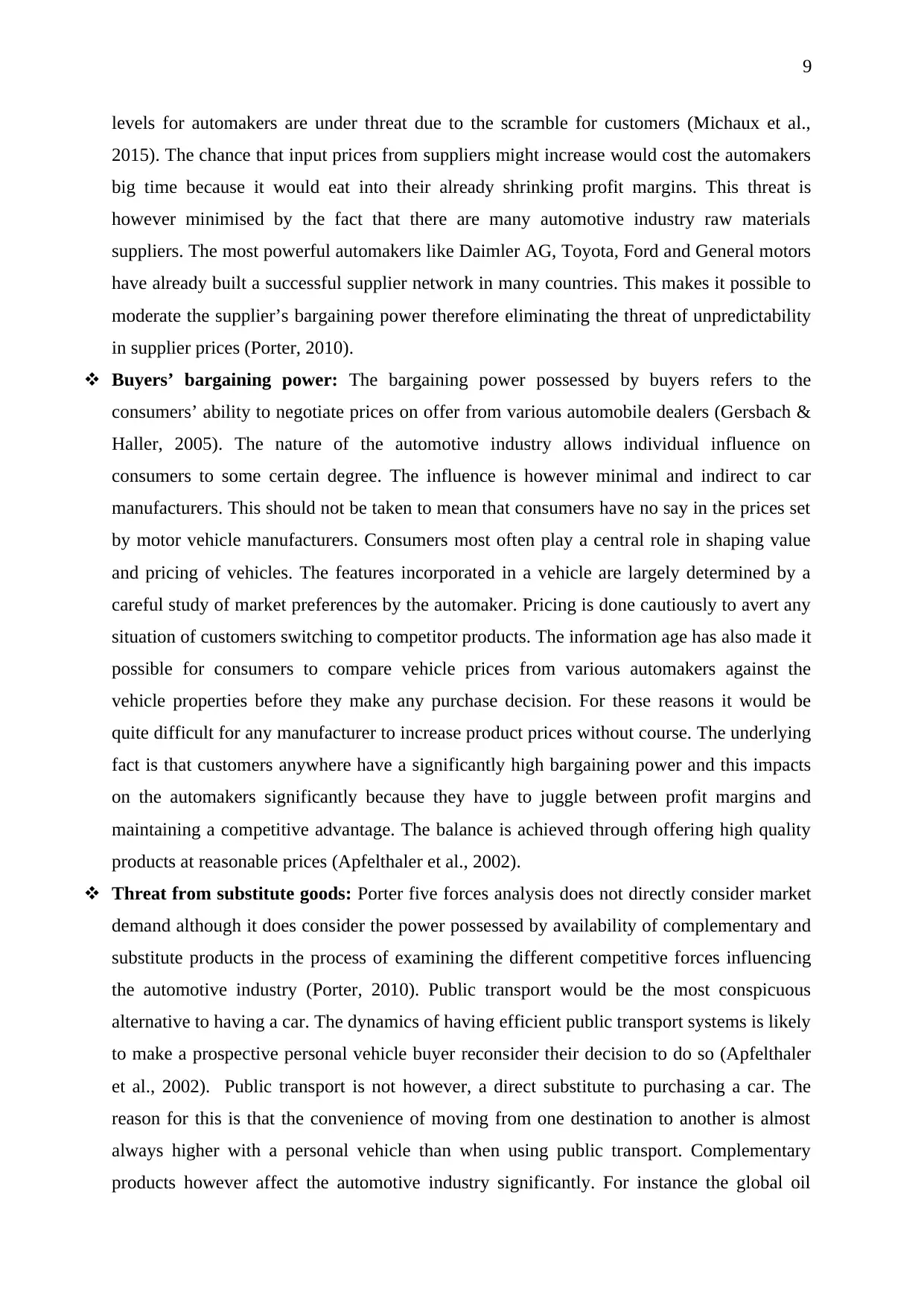
levels for automakers are under threat due to the scramble for customers (Michaux et al.,
2015). The chance that input prices from suppliers might increase would cost the automakers
big time because it would eat into their already shrinking profit margins. This threat is
however minimised by the fact that there are many automotive industry raw materials
suppliers. The most powerful automakers like Daimler AG, Toyota, Ford and General motors
have already built a successful supplier network in many countries. This makes it possible to
moderate the supplier’s bargaining power therefore eliminating the threat of unpredictability
in supplier prices (Porter, 2010).
Buyers’ bargaining power: The bargaining power possessed by buyers refers to the
consumers’ ability to negotiate prices on offer from various automobile dealers (Gersbach &
Haller, 2005). The nature of the automotive industry allows individual influence on
consumers to some certain degree. The influence is however minimal and indirect to car
manufacturers. This should not be taken to mean that consumers have no say in the prices set
by motor vehicle manufacturers. Consumers most often play a central role in shaping value
and pricing of vehicles. The features incorporated in a vehicle are largely determined by a
careful study of market preferences by the automaker. Pricing is done cautiously to avert any
situation of customers switching to competitor products. The information age has also made it
possible for consumers to compare vehicle prices from various automakers against the
vehicle properties before they make any purchase decision. For these reasons it would be
quite difficult for any manufacturer to increase product prices without course. The underlying
fact is that customers anywhere have a significantly high bargaining power and this impacts
on the automakers significantly because they have to juggle between profit margins and
maintaining a competitive advantage. The balance is achieved through offering high quality
products at reasonable prices (Apfelthaler et al., 2002).
Threat from substitute goods: Porter five forces analysis does not directly consider market
demand although it does consider the power possessed by availability of complementary and
substitute products in the process of examining the different competitive forces influencing
the automotive industry (Porter, 2010). Public transport would be the most conspicuous
alternative to having a car. The dynamics of having efficient public transport systems is likely
to make a prospective personal vehicle buyer reconsider their decision to do so (Apfelthaler
et al., 2002). Public transport is not however, a direct substitute to purchasing a car. The
reason for this is that the convenience of moving from one destination to another is almost
always higher with a personal vehicle than when using public transport. Complementary
products however affect the automotive industry significantly. For instance the global oil
⊘ This is a preview!⊘
Do you want full access?
Subscribe today to unlock all pages.

Trusted by 1+ million students worldwide
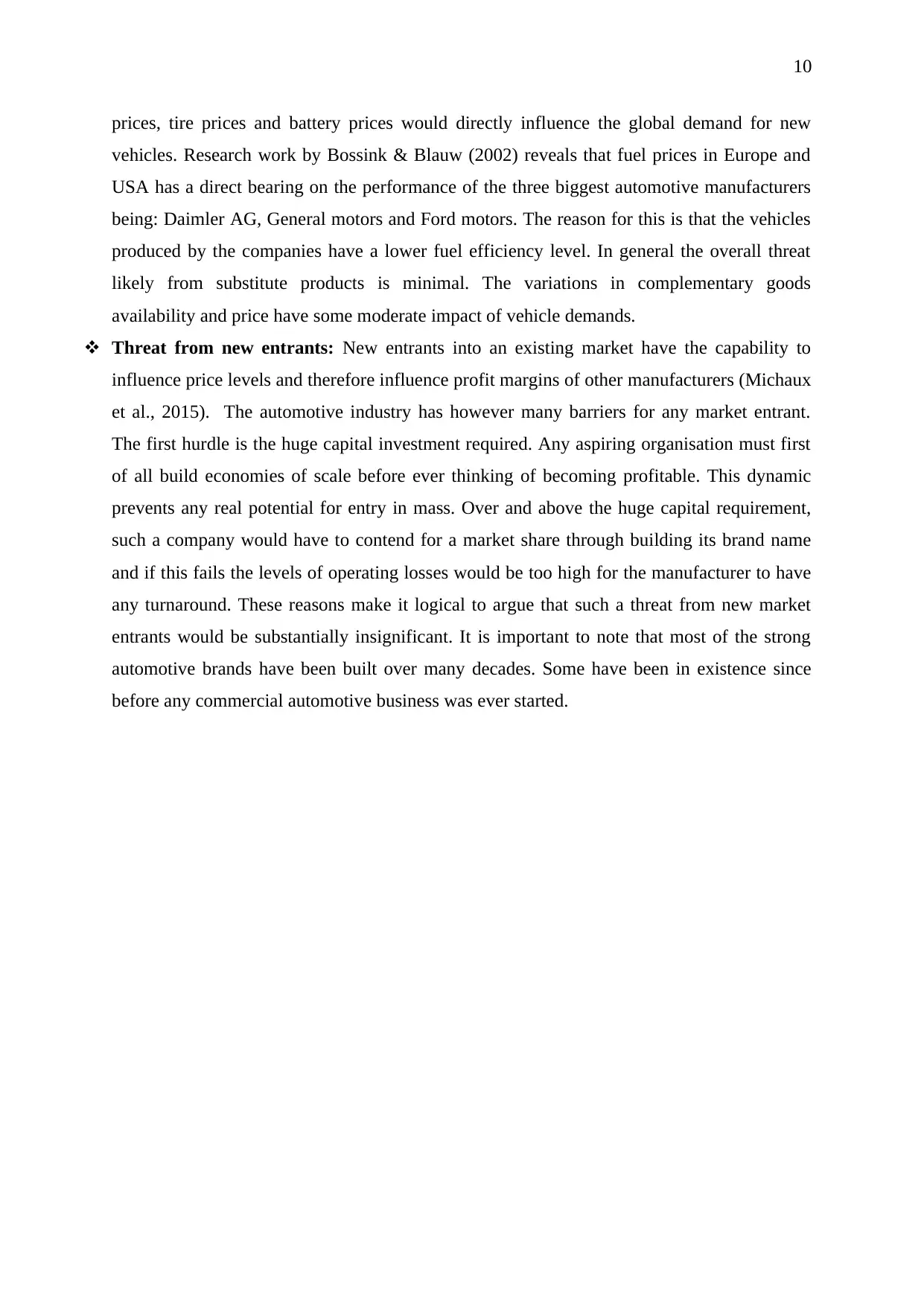
prices, tire prices and battery prices would directly influence the global demand for new
vehicles. Research work by Bossink & Blauw (2002) reveals that fuel prices in Europe and
USA has a direct bearing on the performance of the three biggest automotive manufacturers
being: Daimler AG, General motors and Ford motors. The reason for this is that the vehicles
produced by the companies have a lower fuel efficiency level. In general the overall threat
likely from substitute products is minimal. The variations in complementary goods
availability and price have some moderate impact of vehicle demands.
Threat from new entrants: New entrants into an existing market have the capability to
influence price levels and therefore influence profit margins of other manufacturers (Michaux
et al., 2015). The automotive industry has however many barriers for any market entrant.
The first hurdle is the huge capital investment required. Any aspiring organisation must first
of all build economies of scale before ever thinking of becoming profitable. This dynamic
prevents any real potential for entry in mass. Over and above the huge capital requirement,
such a company would have to contend for a market share through building its brand name
and if this fails the levels of operating losses would be too high for the manufacturer to have
any turnaround. These reasons make it logical to argue that such a threat from new market
entrants would be substantially insignificant. It is important to note that most of the strong
automotive brands have been built over many decades. Some have been in existence since
before any commercial automotive business was ever started.
Paraphrase This Document
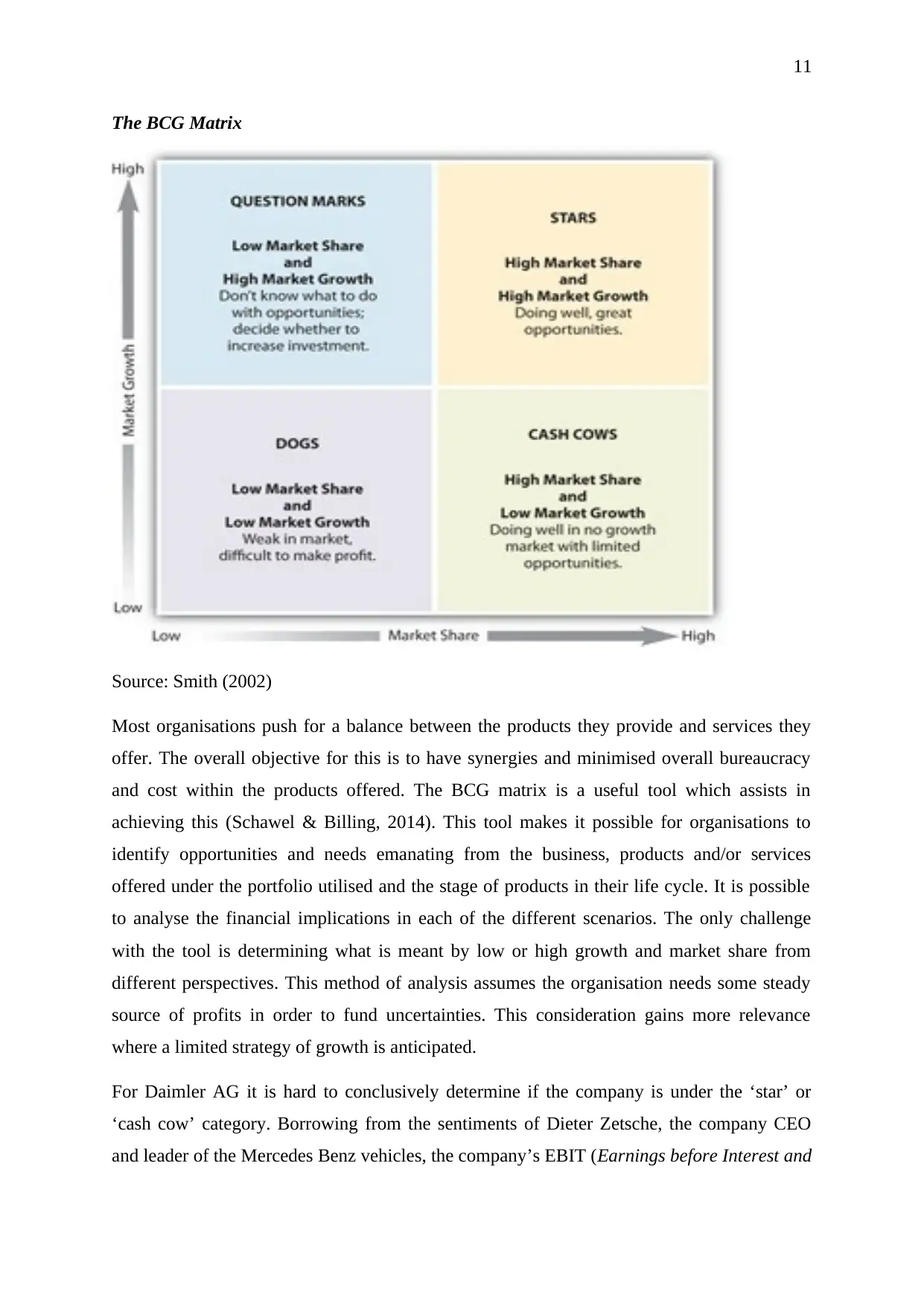
The BCG Matrix
Source: Smith (2002)
Most organisations push for a balance between the products they provide and services they
offer. The overall objective for this is to have synergies and minimised overall bureaucracy
and cost within the products offered. The BCG matrix is a useful tool which assists in
achieving this (Schawel & Billing, 2014). This tool makes it possible for organisations to
identify opportunities and needs emanating from the business, products and/or services
offered under the portfolio utilised and the stage of products in their life cycle. It is possible
to analyse the financial implications in each of the different scenarios. The only challenge
with the tool is determining what is meant by low or high growth and market share from
different perspectives. This method of analysis assumes the organisation needs some steady
source of profits in order to fund uncertainties. This consideration gains more relevance
where a limited strategy of growth is anticipated.
For Daimler AG it is hard to conclusively determine if the company is under the ‘star’ or
‘cash cow’ category. Borrowing from the sentiments of Dieter Zetsche, the company CEO
and leader of the Mercedes Benz vehicles, the company’s EBIT (Earnings before Interest and
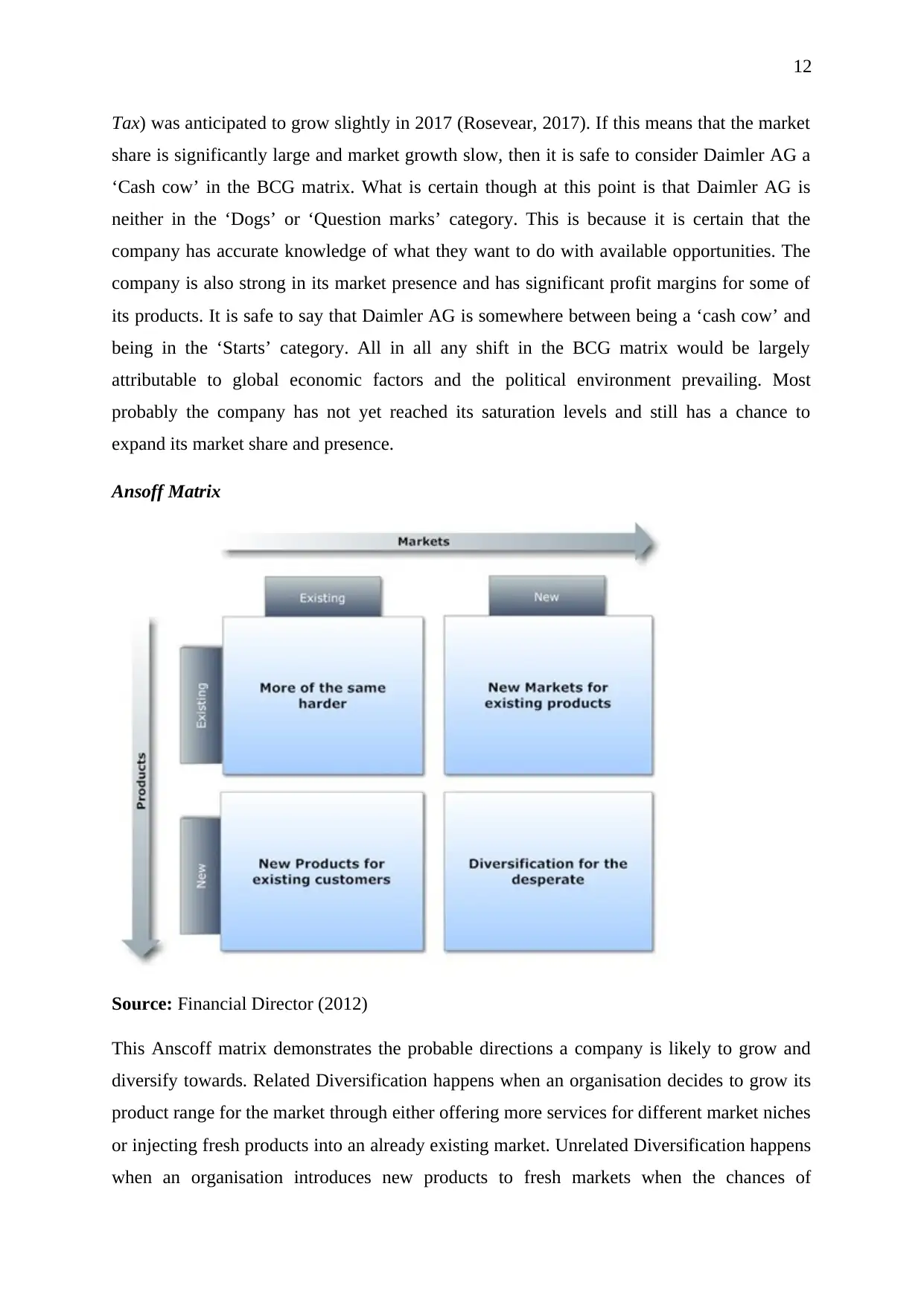
Tax) was anticipated to grow slightly in 2017 (Rosevear, 2017). If this means that the market
share is significantly large and market growth slow, then it is safe to consider Daimler AG a
‘Cash cow’ in the BCG matrix. What is certain though at this point is that Daimler AG is
neither in the ‘Dogs’ or ‘Question marks’ category. This is because it is certain that the
company has accurate knowledge of what they want to do with available opportunities. The
company is also strong in its market presence and has significant profit margins for some of
its products. It is safe to say that Daimler AG is somewhere between being a ‘cash cow’ and
being in the ‘Starts’ category. All in all any shift in the BCG matrix would be largely
attributable to global economic factors and the political environment prevailing. Most
probably the company has not yet reached its saturation levels and still has a chance to
expand its market share and presence.
Ansoff Matrix
Source: Financial Director (2012)
This Anscoff matrix demonstrates the probable directions a company is likely to grow and
diversify towards. Related Diversification happens when an organisation decides to grow its
product range for the market through either offering more services for different market niches
or injecting fresh products into an already existing market. Unrelated Diversification happens
when an organisation introduces new products to fresh markets when the chances of
⊘ This is a preview!⊘
Do you want full access?
Subscribe today to unlock all pages.

Trusted by 1+ million students worldwide
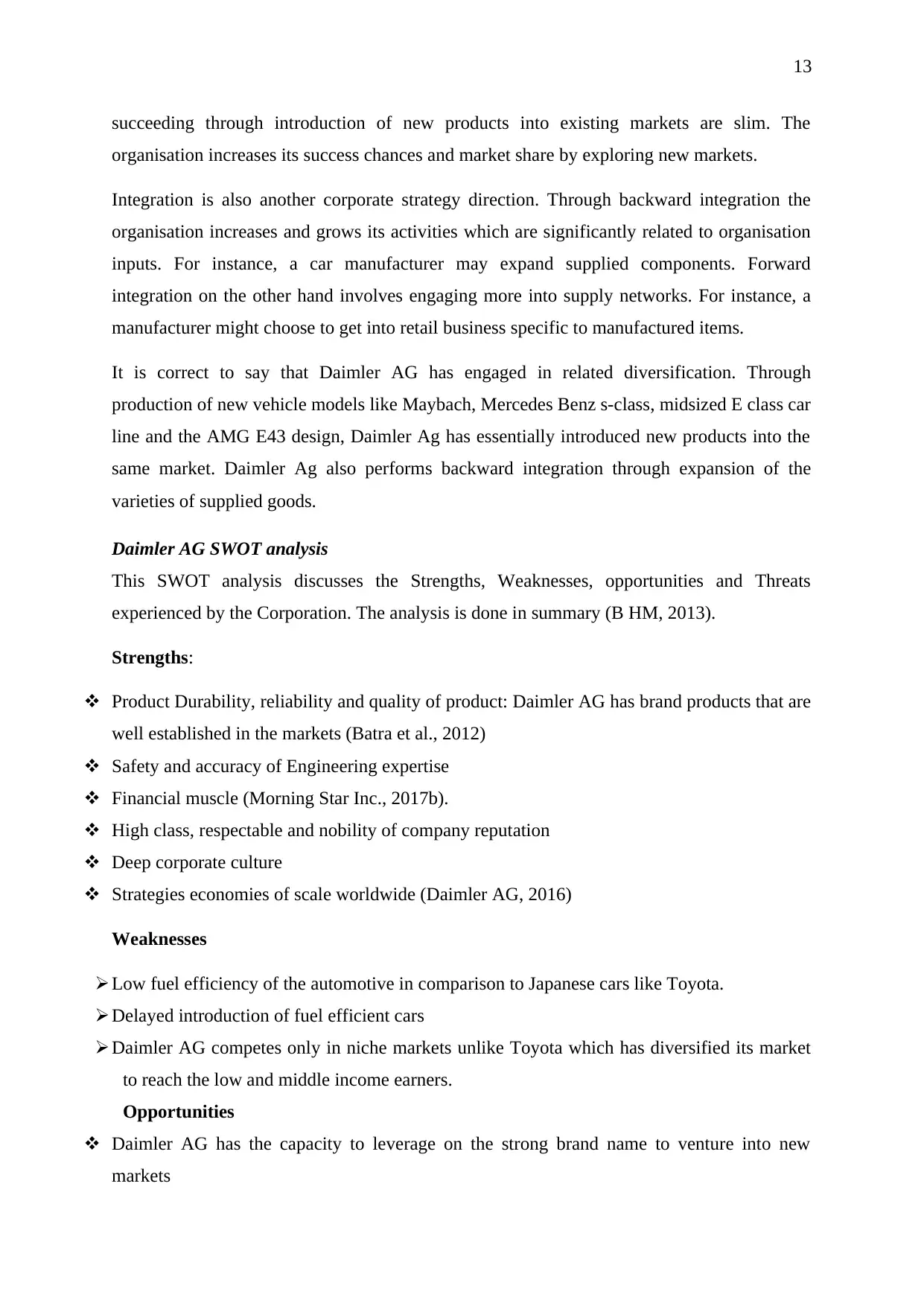
succeeding through introduction of new products into existing markets are slim. The
organisation increases its success chances and market share by exploring new markets.
Integration is also another corporate strategy direction. Through backward integration the
organisation increases and grows its activities which are significantly related to organisation
inputs. For instance, a car manufacturer may expand supplied components. Forward
integration on the other hand involves engaging more into supply networks. For instance, a
manufacturer might choose to get into retail business specific to manufactured items.
It is correct to say that Daimler AG has engaged in related diversification. Through
production of new vehicle models like Maybach, Mercedes Benz s-class, midsized E class car
line and the AMG E43 design, Daimler Ag has essentially introduced new products into the
same market. Daimler Ag also performs backward integration through expansion of the
varieties of supplied goods.
Daimler AG SWOT analysis
This SWOT analysis discusses the Strengths, Weaknesses, opportunities and Threats
experienced by the Corporation. The analysis is done in summary (B HM, 2013).
Strengths:
Product Durability, reliability and quality of product: Daimler AG has brand products that are
well established in the markets (Batra et al., 2012)
Safety and accuracy of Engineering expertise
Financial muscle (Morning Star Inc., 2017b).
High class, respectable and nobility of company reputation
Deep corporate culture
Strategies economies of scale worldwide (Daimler AG, 2016)
Weaknesses
Low fuel efficiency of the automotive in comparison to Japanese cars like Toyota.
Delayed introduction of fuel efficient cars
Daimler AG competes only in niche markets unlike Toyota which has diversified its market
to reach the low and middle income earners.
Opportunities
Daimler AG has the capacity to leverage on the strong brand name to venture into new
markets
Paraphrase This Document
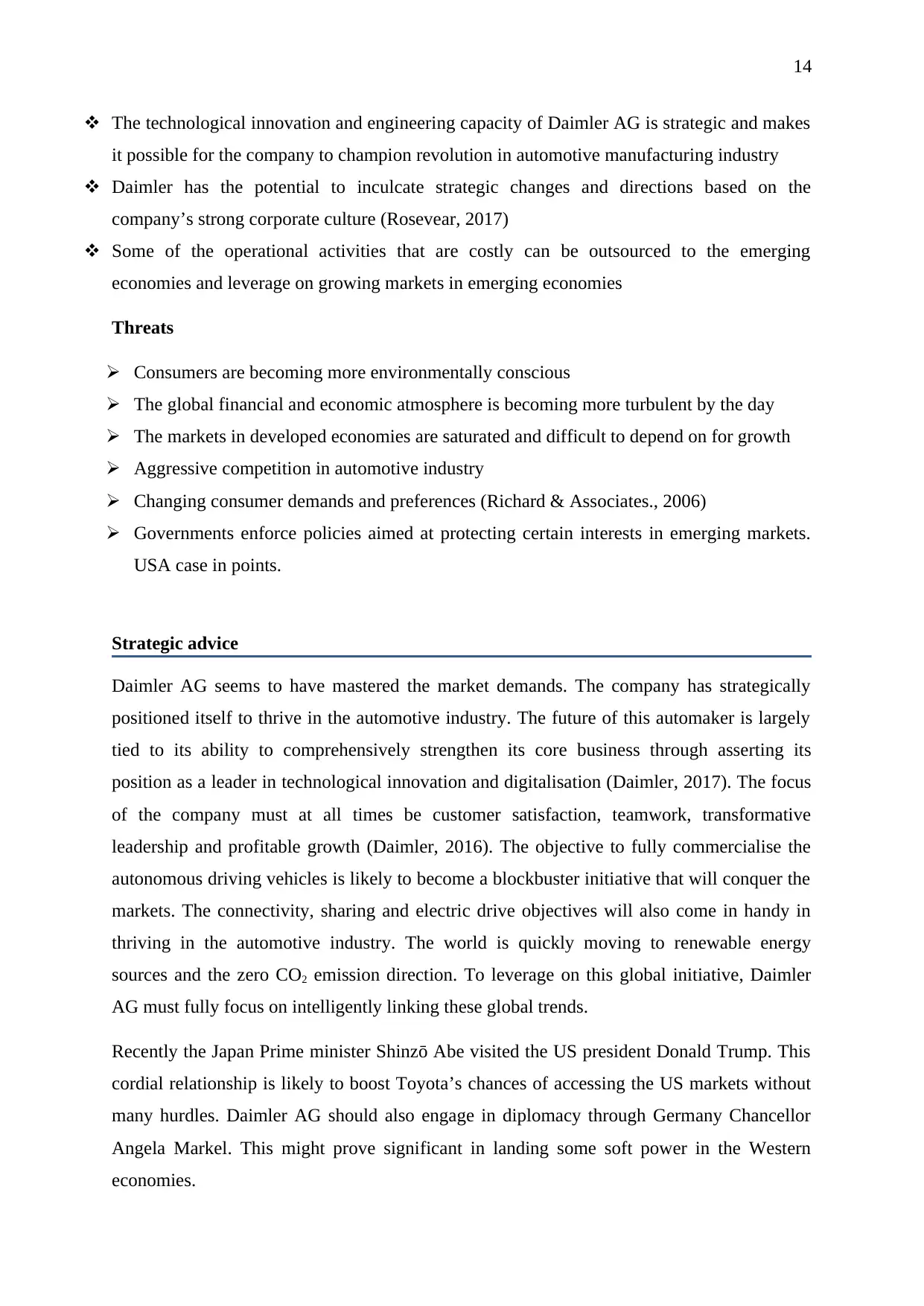
The technological innovation and engineering capacity of Daimler AG is strategic and makes
it possible for the company to champion revolution in automotive manufacturing industry
Daimler has the potential to inculcate strategic changes and directions based on the
company’s strong corporate culture (Rosevear, 2017)
Some of the operational activities that are costly can be outsourced to the emerging
economies and leverage on growing markets in emerging economies
Threats
Consumers are becoming more environmentally conscious
The global financial and economic atmosphere is becoming more turbulent by the day
The markets in developed economies are saturated and difficult to depend on for growth
Aggressive competition in automotive industry
Changing consumer demands and preferences (Richard & Associates., 2006)
Governments enforce policies aimed at protecting certain interests in emerging markets.
USA case in points.
Strategic advice
Daimler AG seems to have mastered the market demands. The company has strategically
positioned itself to thrive in the automotive industry. The future of this automaker is largely
tied to its ability to comprehensively strengthen its core business through asserting its
position as a leader in technological innovation and digitalisation (Daimler, 2017). The focus
of the company must at all times be customer satisfaction, teamwork, transformative
leadership and profitable growth (Daimler, 2016). The objective to fully commercialise the
autonomous driving vehicles is likely to become a blockbuster initiative that will conquer the
markets. The connectivity, sharing and electric drive objectives will also come in handy in
thriving in the automotive industry. The world is quickly moving to renewable energy
sources and the zero CO2 emission direction. To leverage on this global initiative, Daimler
AG must fully focus on intelligently linking these global trends.
Recently the Japan Prime minister Shinzō Abe visited the US president Donald Trump. This
cordial relationship is likely to boost Toyota’s chances of accessing the US markets without
many hurdles. Daimler AG should also engage in diplomacy through Germany Chancellor
Angela Markel. This might prove significant in landing some soft power in the Western
economies.

Daimler AG should also consider opening more subsidiary production plants in South
America, perhaps Brazil or Argentina, where the company enjoys a ready market. This may
be the solution to overcoming the impact caused by an economic recession. In so doing
Daimler AG could be reducing its production cost and at the same time cultivating a positive
appeal in the South American market. The price of its trucks could also come down
considerable.
In order to overcome the challenge of market saturation, Daimler AG should focus more on
emerging markets. One of the major challenges faced by Daimler is the fact that its products
are limited to a niche market. It is important for the company to expand its market by
focusing more on the emerging markets. The only way to succeed in doing so is to expand its
brand. Daimler AG only captures the high middle class earners in exclusion of the low
income earners and the low middle income earners. In order to appeal to this niche Daimler
must tailor products targeting this category of customers just like Toyota has. Focusing only
on a niche market derails any expansion efforts the company might want to invest in.
Recently Daimler AG has ventured into offering financial services and in 2016 recorded
earnings of $421 million which is a growth of 1% from 2015 (Rosevear, 2017). This seems to
be a promising area. The company might find some greater value in financing their customers
to acquire Daimler AG vehicles. A line of credit to the customers and hire purchase
agreements with available financing might do the company some good. Financial strength is a
factor that hinders a willing customer from making a purchase. It would be quite an insight to
empower the customers with the ability to make a purchase. One way the company can
manage to handle this is to allow the customers to pay for products acquired in instalments or
perhaps extend some financial credit at a low interest rate to its customers.
Market segmentation is another idea that Daimler AG should try (Gavett, 2014). Companies
like Vaseline, Nivea, and Colgate have thrived in the markets based on their ability to
segment the market. Daimler AG has the ability to customise products for certain category of
consumers in order to serve various preferences. It is not enough to have a differentiate
product like Mercedes Benz. In order to capitalise more on the market, Daimler must
consider tailoring products meant for specific target groups in the market.
Decision driven marketing is another marketing concept by Joshi & Giménez (2014) that
could help propel Daimler AG further. In this era of climate change and harsh economic
conditions Daimler AG must be able to capitalise on the prevailing customer needs like need
⊘ This is a preview!⊘
Do you want full access?
Subscribe today to unlock all pages.

Trusted by 1+ million students worldwide
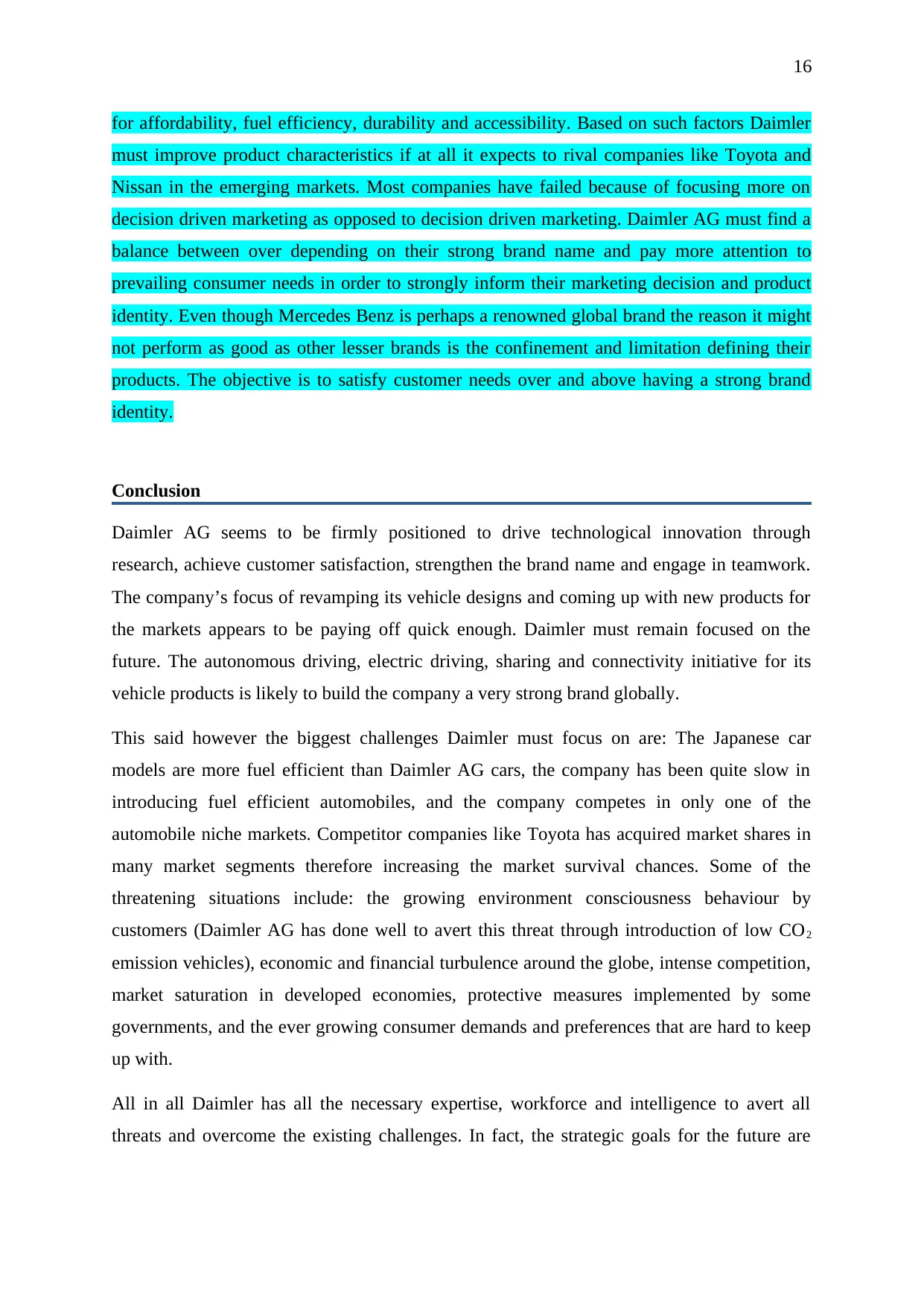
for affordability, fuel efficiency, durability and accessibility. Based on such factors Daimler
must improve product characteristics if at all it expects to rival companies like Toyota and
Nissan in the emerging markets. Most companies have failed because of focusing more on
decision driven marketing as opposed to decision driven marketing. Daimler AG must find a
balance between over depending on their strong brand name and pay more attention to
prevailing consumer needs in order to strongly inform their marketing decision and product
identity. Even though Mercedes Benz is perhaps a renowned global brand the reason it might
not perform as good as other lesser brands is the confinement and limitation defining their
products. The objective is to satisfy customer needs over and above having a strong brand
identity.
Conclusion
Daimler AG seems to be firmly positioned to drive technological innovation through
research, achieve customer satisfaction, strengthen the brand name and engage in teamwork.
The company’s focus of revamping its vehicle designs and coming up with new products for
the markets appears to be paying off quick enough. Daimler must remain focused on the
future. The autonomous driving, electric driving, sharing and connectivity initiative for its
vehicle products is likely to build the company a very strong brand globally.
This said however the biggest challenges Daimler must focus on are: The Japanese car
models are more fuel efficient than Daimler AG cars, the company has been quite slow in
introducing fuel efficient automobiles, and the company competes in only one of the
automobile niche markets. Competitor companies like Toyota has acquired market shares in
many market segments therefore increasing the market survival chances. Some of the
threatening situations include: the growing environment consciousness behaviour by
customers (Daimler AG has done well to avert this threat through introduction of low CO2
emission vehicles), economic and financial turbulence around the globe, intense competition,
market saturation in developed economies, protective measures implemented by some
governments, and the ever growing consumer demands and preferences that are hard to keep
up with.
All in all Daimler has all the necessary expertise, workforce and intelligence to avert all
threats and overcome the existing challenges. In fact, the strategic goals for the future are
Paraphrase This Document
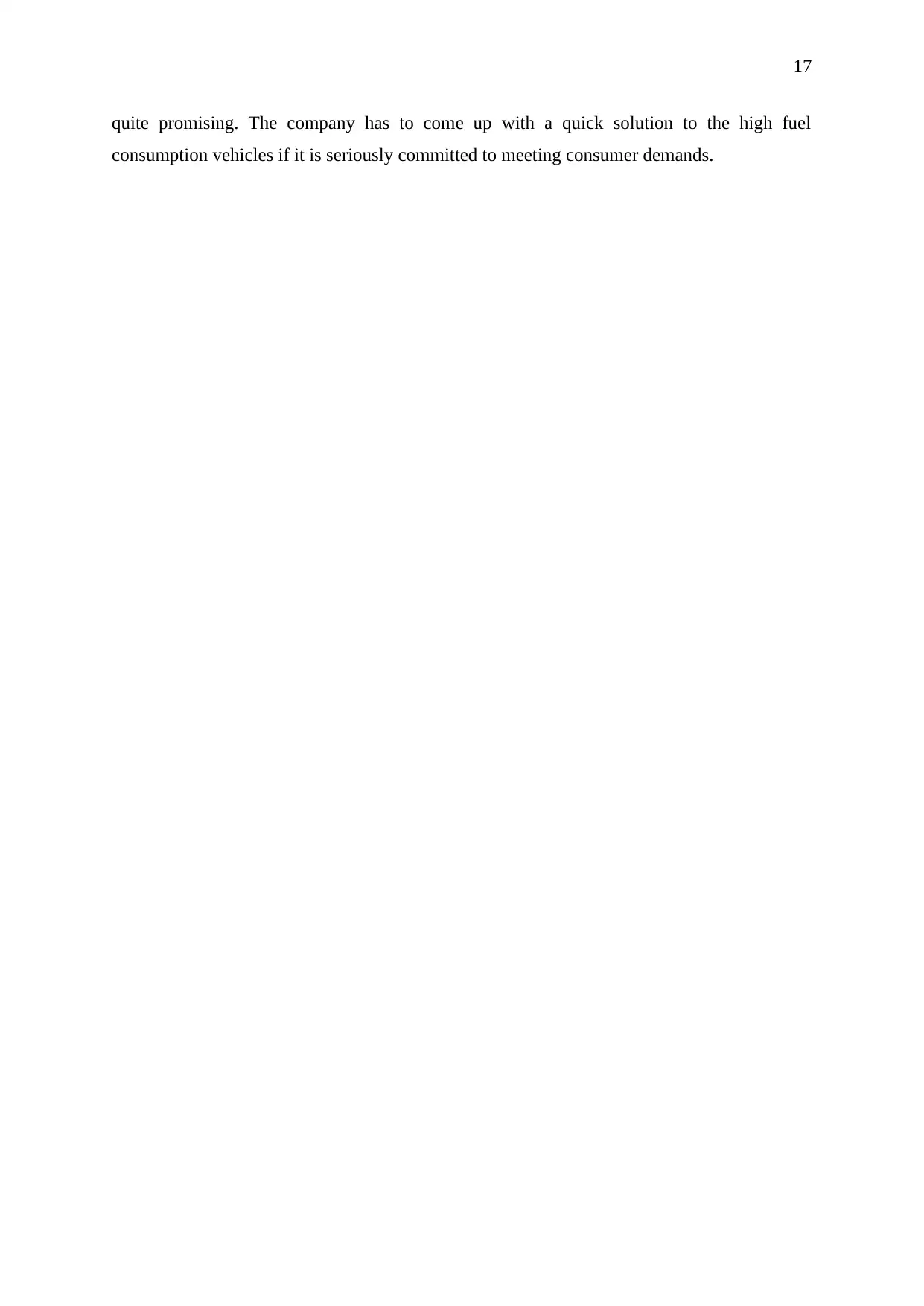
quite promising. The company has to come up with a quick solution to the high fuel
consumption vehicles if it is seriously committed to meeting consumer demands.
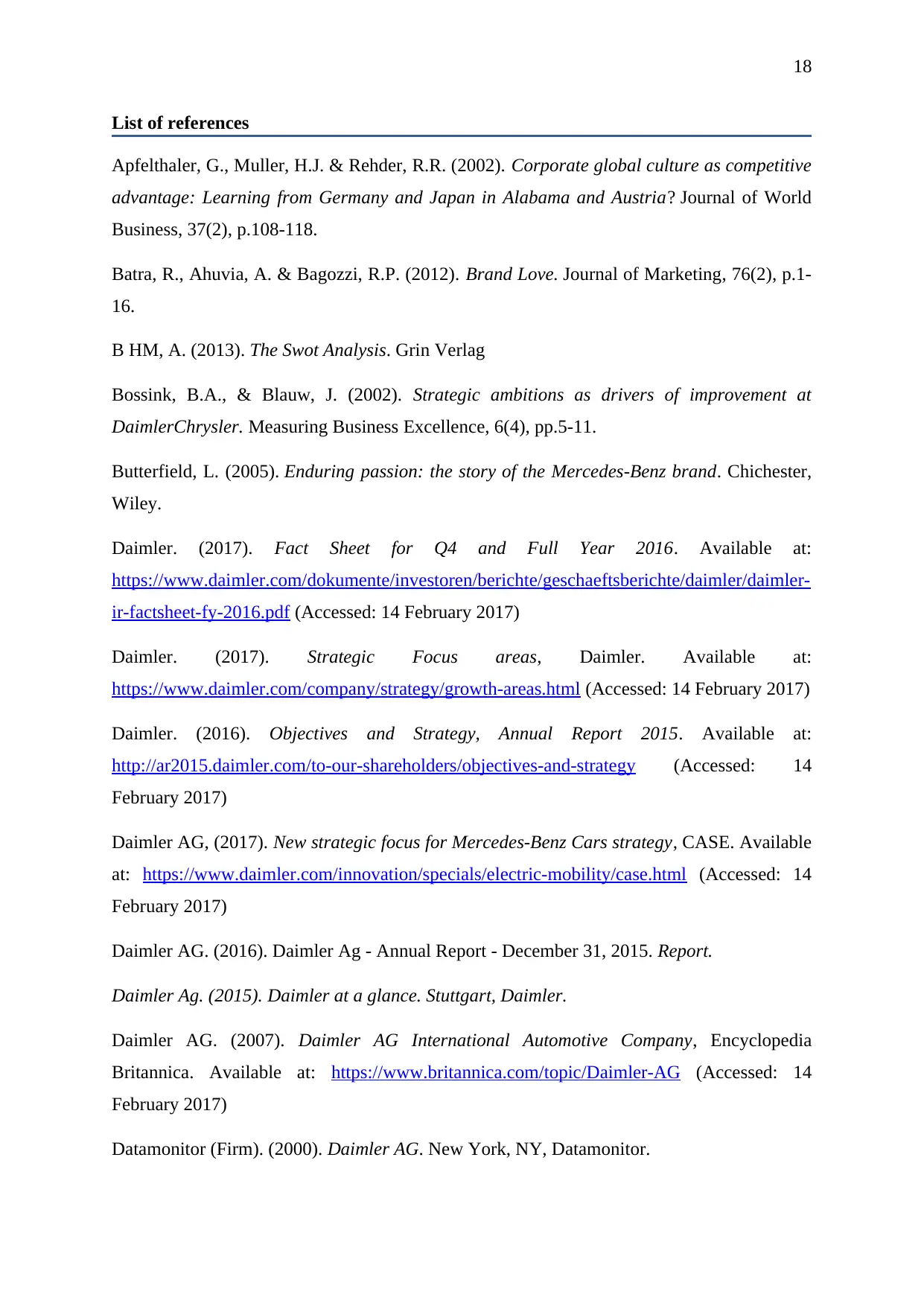
List of references
Apfelthaler, G., Muller, H.J. & Rehder, R.R. (2002). Corporate global culture as competitive
advantage: Learning from Germany and Japan in Alabama and Austria? Journal of World
Business, 37(2), p.108-118.
Batra, R., Ahuvia, A. & Bagozzi, R.P. (2012). Brand Love. Journal of Marketing, 76(2), p.1-
16.
B HM, A. (2013). The Swot Analysis. Grin Verlag
Bossink, B.A., & Blauw, J. (2002). Strategic ambitions as drivers of improvement at
DaimlerChrysler. Measuring Business Excellence, 6(4), pp.5-11.
Butterfield, L. (2005). Enduring passion: the story of the Mercedes-Benz brand. Chichester,
Wiley.
Daimler. (2017). Fact Sheet for Q4 and Full Year 2016. Available at:
https://www.daimler.com/dokumente/investoren/berichte/geschaeftsberichte/daimler/daimler-
ir-factsheet-fy-2016.pdf (Accessed: 14 February 2017)
Daimler. (2017). Strategic Focus areas, Daimler. Available at:
https://www.daimler.com/company/strategy/growth-areas.html (Accessed: 14 February 2017)
Daimler. (2016). Objectives and Strategy, Annual Report 2015. Available at:
http://ar2015.daimler.com/to-our-shareholders/objectives-and-strategy (Accessed: 14
February 2017)
Daimler AG, (2017). New strategic focus for Mercedes-Benz Cars strategy, CASE. Available
at: https://www.daimler.com/innovation/specials/electric-mobility/case.html (Accessed: 14
February 2017)
Daimler AG. (2016). Daimler Ag - Annual Report - December 31, 2015. Report.
Daimler Ag. (2015). Daimler at a glance. Stuttgart, Daimler.
Daimler AG. (2007). Daimler AG International Automotive Company, Encyclopedia
Britannica. Available at: https://www.britannica.com/topic/Daimler-AG (Accessed: 14
February 2017)
Datamonitor (Firm). (2000). Daimler AG. New York, NY, Datamonitor.
⊘ This is a preview!⊘
Do you want full access?
Subscribe today to unlock all pages.

Trusted by 1+ million students worldwide
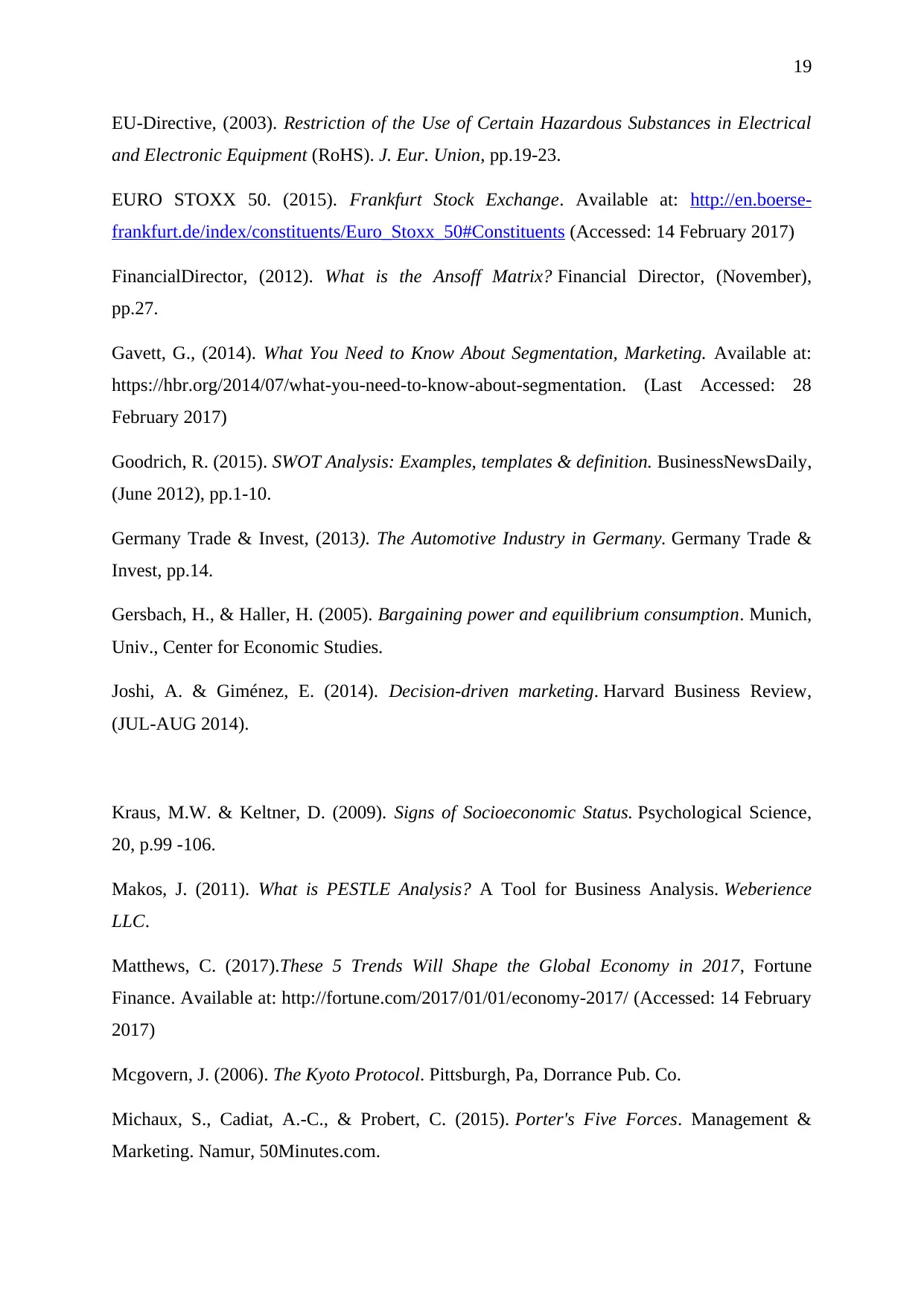
EU-Directive, (2003). Restriction of the Use of Certain Hazardous Substances in Electrical
and Electronic Equipment (RoHS). J. Eur. Union, pp.19-23.
EURO STOXX 50. (2015). Frankfurt Stock Exchange. Available at: http://en.boerse-
frankfurt.de/index/constituents/Euro_Stoxx_50#Constituents (Accessed: 14 February 2017)
FinancialDirector, (2012). What is the Ansoff Matrix? Financial Director, (November),
pp.27.
Gavett, G., (2014). What You Need to Know About Segmentation, Marketing. Available at:
https://hbr.org/2014/07/what-you-need-to-know-about-segmentation. (Last Accessed: 28
February 2017)
Goodrich, R. (2015). SWOT Analysis: Examples, templates & definition. BusinessNewsDaily,
(June 2012), pp.1-10.
Germany Trade & Invest, (2013). The Automotive Industry in Germany. Germany Trade &
Invest, pp.14.
Gersbach, H., & Haller, H. (2005). Bargaining power and equilibrium consumption. Munich,
Univ., Center for Economic Studies.
Joshi, A. & Giménez, E. (2014). Decision-driven marketing. Harvard Business Review,
(JUL-AUG 2014).
Kraus, M.W. & Keltner, D. (2009). Signs of Socioeconomic Status. Psychological Science,
20, p.99 -106.
Makos, J. (2011). What is PESTLE Analysis? A Tool for Business Analysis. Weberience
LLC.
Matthews, C. (2017).These 5 Trends Will Shape the Global Economy in 2017, Fortune
Finance. Available at: http://fortune.com/2017/01/01/economy-2017/ (Accessed: 14 February
2017)
Mcgovern, J. (2006). The Kyoto Protocol. Pittsburgh, Pa, Dorrance Pub. Co.
Michaux, S., Cadiat, A.-C., & Probert, C. (2015). Porter's Five Forces. Management &
Marketing. Namur, 50Minutes.com.
Paraphrase This Document
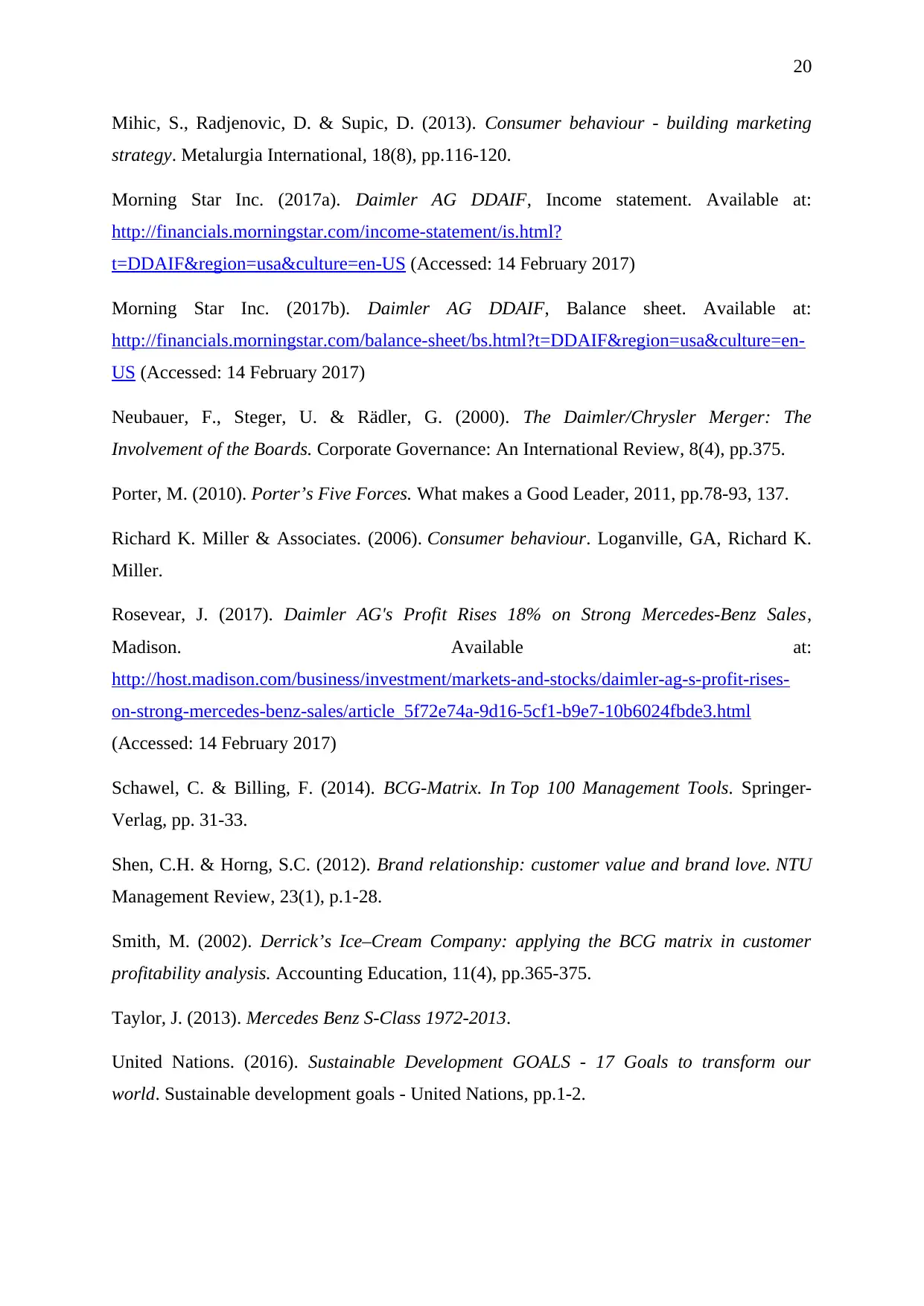
Mihic, S., Radjenovic, D. & Supic, D. (2013). Consumer behaviour - building marketing
strategy. Metalurgia International, 18(8), pp.116-120.
Morning Star Inc. (2017a). Daimler AG DDAIF, Income statement. Available at:
http://financials.morningstar.com/income-statement/is.html?
t=DDAIF®ion=usa&culture=en-US (Accessed: 14 February 2017)
Morning Star Inc. (2017b). Daimler AG DDAIF, Balance sheet. Available at:
http://financials.morningstar.com/balance-sheet/bs.html?t=DDAIF®ion=usa&culture=en-
US (Accessed: 14 February 2017)
Neubauer, F., Steger, U. & Rädler, G. (2000). The Daimler/Chrysler Merger: The
Involvement of the Boards. Corporate Governance: An International Review, 8(4), pp.375.
Porter, M. (2010). Porterʼs Five Forces. What makes a Good Leader, 2011, pp.78-93, 137.
Richard K. Miller & Associates. (2006). Consumer behaviour. Loganville, GA, Richard K.
Miller.
Rosevear, J. (2017). Daimler AG's Profit Rises 18% on Strong Mercedes-Benz Sales,
Madison. Available at:
http://host.madison.com/business/investment/markets-and-stocks/daimler-ag-s-profit-rises-
on-strong-mercedes-benz-sales/article_5f72e74a-9d16-5cf1-b9e7-10b6024fbde3.html
(Accessed: 14 February 2017)
Schawel, C. & Billing, F. (2014). BCG-Matrix. In Top 100 Management Tools. Springer-
Verlag, pp. 31-33.
Shen, C.H. & Horng, S.C. (2012). Brand relationship: customer value and brand love. NTU
Management Review, 23(1), p.1-28.
Smith, M. (2002). Derrickʼs Ice–Cream Company: applying the BCG matrix in customer
profitability analysis. Accounting Education, 11(4), pp.365-375.
Taylor, J. (2013). Mercedes Benz S-Class 1972-2013.
United Nations. (2016). Sustainable Development GOALS - 17 Goals to transform our
world. Sustainable development goals - United Nations, pp.1-2.
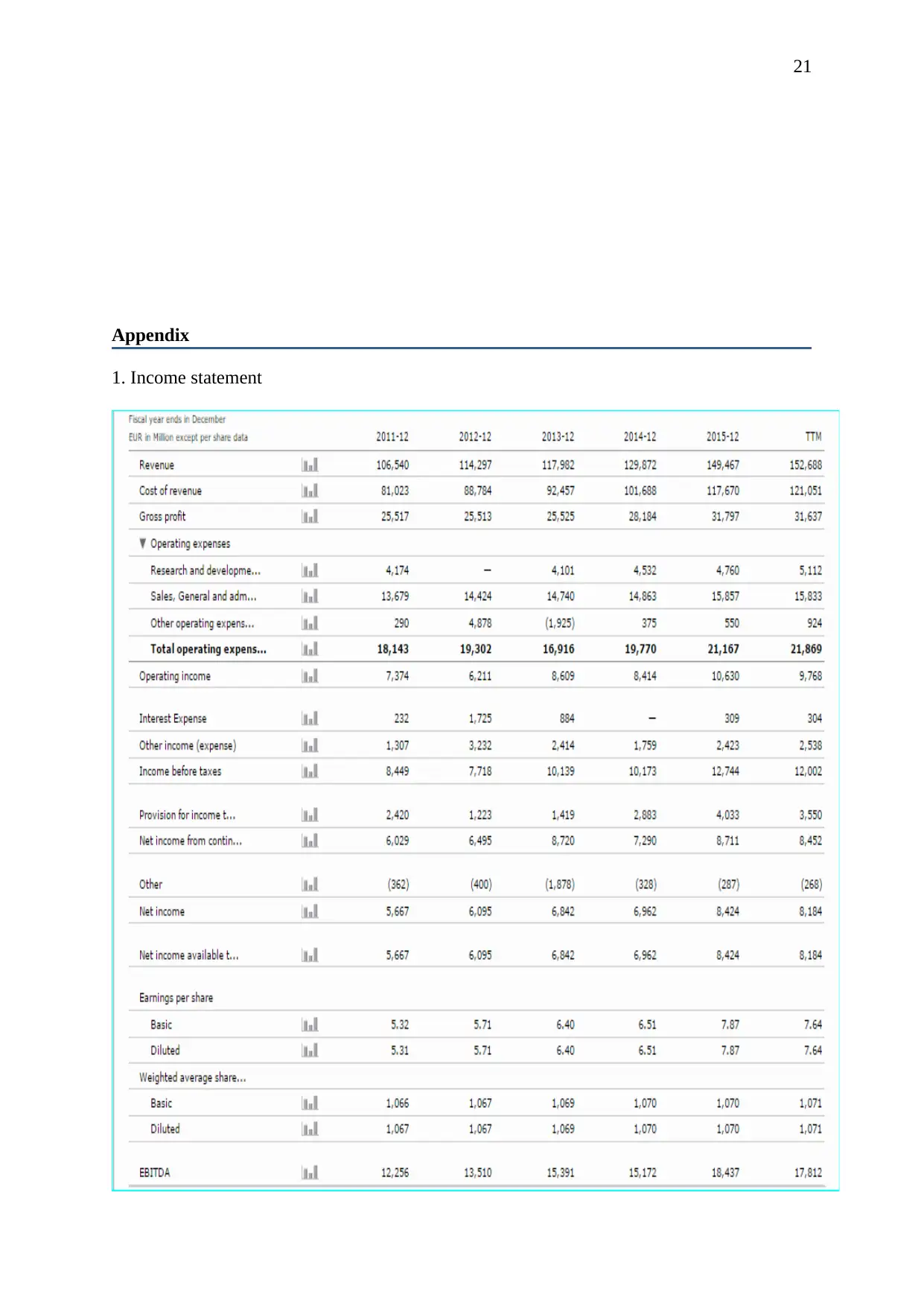
Appendix
1. Income statement
⊘ This is a preview!⊘
Do you want full access?
Subscribe today to unlock all pages.

Trusted by 1+ million students worldwide

2. Total Assets
3. Revenue
Paraphrase This Document

4. EBIT
Related Documents
Your All-in-One AI-Powered Toolkit for Academic Success.
+13062052269
info@desklib.com
Available 24*7 on WhatsApp / Email
![[object Object]](/_next/static/media/star-bottom.7253800d.svg)
© 2024 | Zucol Services PVT LTD | All rights reserved.





